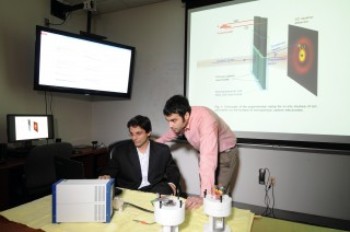Feb 28 2013
The adsorption of ions in microporous materials governs the operation of technologies as diverse as water desalination, energy storage, sensing and mechanical actuation.
 Georgia Tech associate professor Gleb Yushin (left) and graduate research assistant Sofiane Boukhalfa examine experimental results from their study of the adsorption of ions. Georgia Tech Photo: Gary Meek
Georgia Tech associate professor Gleb Yushin (left) and graduate research assistant Sofiane Boukhalfa examine experimental results from their study of the adsorption of ions. Georgia Tech Photo: Gary Meek
Until now, however, researchers attempting to improve the performance of these technologies haven’t been able to directly and unambiguously identify how factors such as pore size, pore surface chemistry and electrolyte properties affect the concentration of ions in these materials as a function of the applied potential.
To provide the needed information, researchers at the Georgia Institute of Technology and the Oak Ridge National Laboratory have demonstrated that a technique known as small angle neutron scattering (SANS) can be used to study the effects of ions moving into nanoscale pores. Believed to be the first application of the SANS technique for studying ion surface adsorption in-situ, details of the research were reported recently in the journal Angewandte Chemie International Edition.
Using conductive nanoporous carbon, the researchers conducted proof-of-concept experiments to measure changes in the adsorption of hydrogen ions in pores of different sizes within the same material due to variations in solvent properties and applied electrical potential. Systematic studies performed with such a technique could ultimately help identify the optimal pore size, surface chemistry and electrolyte solvent properties necessary for either maximizing or minimizing the adsorption of ions under varying conditions.
“We need to understand this system better so we can predict the kind of surface chemistry required and the kinds of solvents needed to control the levels of ion penetration and adsorption in pores of different sizes,” said Gleb Yushin, an associate professor in the Georgia Tech School of Materials Science and Engineering. “Understanding these processes better could lead to the development of improved energy storage, water purification and desalination systems. This new experimental methodology may also give us paths to better understand ion transport in biological systems and contribute to the development of improved drugs and artificial organs.”
The research was supported partially by the U.S. Army Research Office, the Georgia Institute of Technology and the Oak Ridge National Laboratory (ORNL).
“The advantage of neutron scattering is that it can be used to study real systems,” said Yushin. “You can study most electrode materials and electrolyte combinations as long as they have a high sensitivity for neutron scattering.”
Yushin and his collaborators – Georgia Tech graduate research assistant Sofiane Boukhalfa, and Oak Ridge scientists Yuri Melnichenko and Lilin He – conducted the research using ORNL’s High Flux Isotope Reactor, which produces a beam of high-energy neutrons. Their experimental setup allowed them to immerse activated carbon fabric samples – each sample containing pores of different sizes – in different electrolyte materials while varying the applied electrical potential.
By measuring how the neutron beam was scattered when it passed through the carbon fabric and electrolytes, the researchers could determine how the solvent, pore size and electrical potential affected the average ion concentration in the carbon material samples.
“You can learn whether the ions get adsorbed into small pores or large pores by simply comparing the changes in the neutron scattering,” Yushin explained. “This experimental technique allows us to independently change the surface chemistry to see how that affects the ion concentrations, and we can use different solvents to observe how the interaction between electrolyte and pore walls affects the ion adsorption in pores of different sizes. We can further identify exactly where the ion adsorption takes place even when no potential is applied to an electrode.”
Earlier work in this area had not provided clear results.
“There have been multiple prior studies on the pore size effect, but different research groups worldwide have obtained contradictory results depending on the material selection and the model used to determine the specific surface area and pore size distribution in carbon electrodes,” Yushin said. “Neutron scattering should help us clarify existing controversies. We have already observed that depending on the solvent-pore wall interactions, either enhanced or reduced ion electro-adsorption may take place in sub-nanometer pores.”
In their experiments, the researchers used two different electrolytes: water containing sulfuric acid and deuterium oxide – also known as heavy water – which also contained sulfuric acid. The two were chosen for the proof-of-concept experiments, though a wide range of other hydrogen-containing electrolytes could also be used.
Now that the technique has been shown to work, Yushin would like to expand the experimentation to develop better fundamental understanding about the complex interactions of solvent, ions and pore walls under applied potential. That could allow development of a model that could guide the design of future systems that depend on ion transport and adsorption.
“Once you gain the fundamental knowledge from SANS experiments, predictive theoretical models could be developed that would guide the synthesis of the optimal structures for these applications,” he said. “Once you clearly understand the structure-property relationships, you can use materials science approaches to design and synthesize the optimal material with the desired properties.”
Information developed through the research could lead to improvements in supercapacitors and hybrid battery-capacitor devices for rapidly growing applications in hybrid electrical vehicles, energy efficient industrial equipment, smart grid-distributed energy storage, hybrid-electric and electrical ships, high-power energy storage for wind power and uninterruptible power supplies.
This research was partially supported by the Georgia Institute of Technology and the U.S. Army Research Office under contract number W911NF-12-1-0259. The research at ORNL’s High Flux Isotope Reactor was sponsored by the Laboratory Directed Research and Development Program and the Scientific User Facilities Division, Office of Basic Energy Sciences, U.S. Department of Energy. The conclusions are those of the authors and do not necessarily reflect the official positions of the U.S. Army Research Office or the Department of Energy.
Source: http://www.gatech.edu/